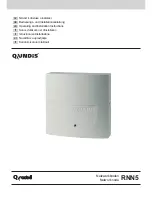
Chapter 12: Spanning Tree Protocols on the Switch
144
Overview
Both STP and RSTP guard against the formation of loops in an Ethernet
network topology. A topology has a loop when two or more nodes can
transmit packets to each other over more than one data path. Packets can
become caught in repeating cycles, referred to as broadcast storms, that
needlessly consume network bandwidth and that can significantly reduce
network performance.
STP and RSTP prevent loops from forming by ensuring that only one path
exists between the end nodes in your network. Where multiple paths exist,
these protocols place the extra paths in a standby or blocking mode. In
addition, STP and RSTP can activate redundant paths if primary paths go
down. These protocols guard against multiple links between segments
and the risk of broadcast storms and maintain network connectivity by
activating backup redundant paths.
One of the primary differences between the two protocols is in the time
each takes to complete the process referred to as convergence. When a
change is made to the network topology, such as the addition of a new
bridge, a spanning tree protocol determines whether there are redundant
paths that must be blocked to prevent data loops, or activated to maintain
communications between the various network segments. This is the
process of convergence.
With STP, convergence can take up to a minute or more to complete in a
large network. This can result in the loss of communication between
various parts of the network during the convergence process, and the
subsequent lost of data packets.
RSTP is much faster than STP. It can complete a convergence in
seconds, and in turn, greatly diminish the possible impact the process can
have on your network. With STP or RSTP, only one spanning tree can be
active on the switch at a time. The default setting is RSTP.
The AT-8100 Series switch supports MSTP; however, the web browser
interface does not support MSTP configuration. You must use the CLI to
configure MSTP on the switch. See “Multiple Spanning Tree Protocol” in
the
AT-8100 Series Version 2.2.5.0 Management Software Command
Line Interface User’s Guide
.
Summary of Contents for AT-8100L/8POE
Page 4: ......
Page 10: ...Contents 10...
Page 14: ...Figures 14...
Page 22: ...Chapter 1 AT 8100 Series Version 2 2 5 0 Web Browser Interface 22...
Page 84: ...Chapter 5 Setting Port Statistics 84...
Page 92: ...Chapter 6 Port Mirroring 92...
Page 100: ...Chapter 7 Spanning Tree Protocol on a Port 100...
Page 120: ...Chapter 9 Link Aggregation Control Protocol LACP 120...
Page 130: ...Chapter 10 Setting Static Port Trunks 130...
Page 148: ...Chapter 12 Spanning Tree Protocols on the Switch 148...
Page 158: ...Chapter 13 Internet Group Management Protocol IGMP Snooping 158...
Page 168: ...Chapter 14 IGMP Snooping Querier 168...
Page 178: ...Chapter 15 Power Over Ethernet PoE 178...
Page 230: ...Chapter 19 Setting IPv4 and IPv6 Addresses 230...
Page 242: ...Chapter 20 Access Control Lists ACL 242...
Page 246: ...Chapter 21 Setting Static Routes 246 8 Click Apply 9 Click SAVE...
Page 250: ...Chapter 21 Setting Static Routes 250...
Page 319: ...AT 8100 Series Version 2 2 5 0 Web Interface User s Guide 319 Model Name Asset ID...
Page 320: ...Chapter 25 LLDP and LLDP MED 320...
















































